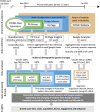Online reach and engagement of a child nutrition peer-education program (PICNIC): insights from social media and web analytics
- PMID: 35473610
- PMCID: PMC9041288
- DOI: 10.1186/s12889-022-13252-3
Online reach and engagement of a child nutrition peer-education program (PICNIC): insights from social media and web analytics
Abstract
Background: Parents frequently seek parental advice online and on social media; thus, these channels should be better utilized in child health interventions. The Parents in Child Nutrition Informing Community (PICNIC) program aims to facilitate peer-to-peer sharing of evidence-based child feeding information and support parents within their social networks. The present study aimed to explore web and social media analytics to evaluate reach and user engagement with the PICNIC online components.
Methods: Online user activity data from the PICNIC Facebook closed group and public Page were collected through Facebook Insights, and program-specific website traffic data through Google Analytics. Analytics data from Nov-2019 to April-2021 was evaluated through visualisation and summary statistics to obtain insights into program growth and current reach in Australia, compare demographics of audience reached through the online channels, and explore parents' use and engagement in PICNIC content.
Results: Results showed steady program growth in the 18 months of recruitment; participant numbers grew from 102 to 261 peer educators while the Facebook Page audience increased threefold, totalling 1615 followers. Intervention posts shared on Facebook (4-5 posts/week) typically reached only a portion of PICNIC Page followers each week, but also reached a wider audience through their friends. Throughout the evaluated period, Facebook users actively engaged in PICNIC posts, although the level of engagement varied considerably from post to post. Furthermore, results from this study suggest the strategy of directing potentially interested parents from social media to the website for program sign-up was successful. Finally, the explored data gave insights into users' availability, demographics and engagement, which will be used to inform refinement of the PICNIC website and social media strategies.
Conclusions: Our findings confirm the benefits of using a peer education approach and existing social network channels to disseminate evidence-based child feeding information to parents. This study also demonstrates the usefulness of web and social media analytics to be used as part of a continuous evaluation for gaining insight to inform further development and improvement of program strategies.
Trial registration: The PICNIC project was retrospectively submitted for registration with the Australian New Zealand Clinical Trials Registry (ANZCTR), ACTRN12622000230752 (09/02/2022).
Keywords: Child feeding practices; Child nutrition; Google analytics; Parents; Peer education; Social media; Website; eHealth intervention.
© 2022. The Author(s).
Conflict of interest statement
The authors declare that they have no competing interests.
Figures










Similar articles
-
Engaging Parents With Child Nutrition and Feeding Information on Facebook: A Retrospective Content Analysis.Food Sci Nutr. 2025 May 25;13(6):e70326. doi: 10.1002/fsn3.70326. eCollection 2025 Jun. Food Sci Nutr. 2025. PMID: 40421414 Free PMC article.
-
Study Protocol of the Parents in Child Nutrition Informing Community (PICNIC) Peer Education Cohort Study to Improve Child Feeding and Dietary Intake of Children Aged Six Months to Three Years Old.Children (Basel). 2019 Dec 27;7(1):3. doi: 10.3390/children7010003. Children (Basel). 2019. PMID: 31892113 Free PMC article.
-
Outcomes in Child Health: Exploring the Use of Social Media to Engage Parents in Patient-Centered Outcomes Research.J Med Internet Res. 2017 Mar 16;19(3):e78. doi: 10.2196/jmir.6655. J Med Internet Res. 2017. PMID: 28302593 Free PMC article.
-
Dementia Research on Facebook and Twitter: Current Practice and Challenges.J Alzheimers Dis. 2022;90(2):447-459. doi: 10.3233/JAD-220525. J Alzheimers Dis. 2022. PMID: 36155513 Free PMC article. Review.
-
Analysis of public engagement with ten major global health topics on a social network profile and a newspaper website.J Glob Health. 2020 Jun;10(1):010902. doi: 10.7189/jogh.10.010902. J Glob Health. 2020. PMID: 32257171 Free PMC article. Review.
Cited by
-
Social Media Influences on Dietary Awareness in Children.Healthcare (Basel). 2024 Oct 2;12(19):1966. doi: 10.3390/healthcare12191966. Healthcare (Basel). 2024. PMID: 39408146 Free PMC article. Review.
-
Engaging Parents With Child Nutrition and Feeding Information on Facebook: A Retrospective Content Analysis.Food Sci Nutr. 2025 May 25;13(6):e70326. doi: 10.1002/fsn3.70326. eCollection 2025 Jun. Food Sci Nutr. 2025. PMID: 40421414 Free PMC article.
-
Using the Healthy Native Youth Implementation Toolbox to Provide Web-Based Adolescent Health Promotion Decision Support to American Indian and Alaska Native Communities: Implementation Study.JMIR Form Res. 2025 Apr 16;9:e67885. doi: 10.2196/67885. JMIR Form Res. 2025. PMID: 40239201 Free PMC article.
-
Virtual dentistry strategy to enhance knowledge, attitudes, and practices in selecting sweetened ultra-processed foods.PLoS One. 2024 Nov 15;19(11):e0312288. doi: 10.1371/journal.pone.0312288. eCollection 2024. PLoS One. 2024. PMID: 39546495 Free PMC article.
References
-
- World Health Organization . Obesity and overweight. 2021.
-
- Commission on Ending Childhood Obesity . Report of the Commission on Ending Childhood Obesity. Geneva: World Health Organization; 2016.
-
- Moore T, Arefadib N, Deery A, Keyes M, West S. The first thousand days: an evidence paper. Melbourne: Centre for Community Child Health; 2017.
Publication types
MeSH terms
LinkOut - more resources
Full Text Sources
Miscellaneous

